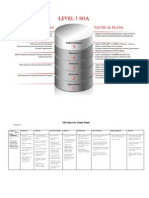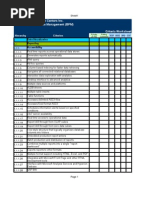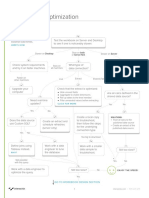B.I Week 2 Lesson 1 1.0d
B.I Week 2 Lesson 1 1.0d
Uploaded by
jamal rashidCopyright:
Available Formats
B.I Week 2 Lesson 1 1.0d
B.I Week 2 Lesson 1 1.0d
Uploaded by
jamal rashidCopyright
Available Formats
Share this document
Did you find this document useful?
Is this content inappropriate?
Copyright:
Available Formats
B.I Week 2 Lesson 1 1.0d
B.I Week 2 Lesson 1 1.0d
Uploaded by
jamal rashidCopyright:
Available Formats
Information Systems Program
Business Intelligence
Concepts,
Tools, and Applications
Week 2: Business Intelligence Concepts and Platform
Capabilities
Lesson : BI Concepts
Information Systems Program
BI Concepts
• Learning Objectives
• Define Business Intelligence
• Learn Evolution of Business Intelligence Capabilities
• Define BI architecture and its components
• Summarize main applications and business value for BI
Information Systems Program
What is Business Intelligence
• Business Intelligence (BI) is an umbrella term that
combines architectures, databases, analytical tools,
applications, and methodologies.
• The Data Warehousing Institute (TDWI 2002) working
definition of business intelligence:
• “The processes, technologies, and tools needed to turn data into
information, information into knowledge, and knowledge into
plans that drive profitable business action. Business intelligence
encompasses data warehousing, business analytic tools and
content/knowledge management”
Information Systems Program
Evolution of BI Capabilities
From SHARDA, RAMESH; DELEN, DURSUN; TURBAN, EFRAIM, BUSINESS 3
INTELLIGENCE AND ANALYTICS: SYSTEMS FOR DECISION SUPPORT, 10th
Edition, © 2015. Used by permission of Pearson Education, Inc., New York, NY.
All Rights Reserved.
Information Systems Program
A High-Level BI Architecture
Data Warehouse Business Analytics Performance and
Environment Environment Strategy
Data Technical staff Business users Managers / executives
Sources Built the data warehouse Access
Data
ü Organizing Warehouse BPM strategy
ü Summarizing Manipulation
ü Standardizing Results
User Interface
Future component - browser
intelligent systems - portal
- dashboard
Source: Eckerson, W. Smart Companies in the 21st Century: 4
The Secrets of Creating Successful Business Intelligent
Solutions. The Data Warehousing Institute, Seattle, WA, 2003,
p. 32
Information Systems Program
Detailed level BI Architecture
5
Based on: Pant, P. Business intelligence (BI): How to build
successful BI Strategy, Deloitte Consulting LLP. 2009.
Information Systems Program
Source Systems
• Many possible sources – (ERP, Ticket and Change
management system, point of sale, legacy system,
unstructured data, etc.)
• Many platforms – IBM, Oracle, Microsoft, Sybase, SAS
• Many formats – Relational, Hierarchical, Columnar,
Multi-dimensional, Big data MapReduce Databases,
Unstructured text data
Information Systems Program
BI Services components
• Integration Services (ETL, Operational Data Feeds,
Enterprise Application Integration, Enterprise
Information Integration)
• Data Management Services (data warehouse, data
marts, federated data marts, OLAP cubes, etc.)
• Reporting and Analytical Services (Analytical Reporting,
ad-hoc query and batch reporting,
dashboards/scorecards, predictive and prescriptive
modeling, data & text mining/forecasting)
• Information Delivery and Consumption Services (Web
portals, subscription, direct user access, internal portals 7
Information Systems Program
Types of
• IT developers
BI users
• Analysts
• Information workers
• Managers and executives
• Front line workers
• Suppliers, customers, and regulators
Source Watson, H. J., "Tutorial: Business Intelligence –Past, Present, and 8
Future," Communications of the Association for Information Systems: Vol. 25,
Article 39, 2009.
Information Systems Program
BI Applications
• Business intelligence (BI) used for decision making can
be broken into three main types of applications:
• Strategic
• Tactical
• Operational
See White, C. Critical Agility: Operational BI Generates
Faster and Smarter Decisions., TeraData Magazine Volume 9
9, No. 1, March 2009.
Information Systems Program
Strategic BI Applications
• Such applications help executives as well as business
and financial analysts assess progress in achieving long-
term, enterprise-wide goals such as increased revenue
or market share, reduced costs, better customer
retention and improved profitability.
• For example, Strategic dashboards can reflect enterprise-wide
strategic goals, as well as corresponding KPIs.
• Features on this type of dashboard include global, external,
trends and growth measures, all of which are related to or
based on the Balanced Scorecard Methodology
10
Source White, C. Critical Agility: Operational BI Generates Faster and
Smarter Decisions., TeraData Magazine Volume 9, No. 1, March
2009.
Information Systems Program
Tactical BI Applications
• These focus on analyzing short-term initiatives within
specific line-of-business domains, such as marketing,
sales, purchasing or customer service. Helping sales
managers optimize their region-wide campaigns is an
example of this type of BI application. For example:
• Tactical (also called analytical) dashboards measure the
business’s progress according to related trends, in accordance
with each strategic initiative. Progress is measured against a
preset goal, such as a budget or a certain target.
• Drilldowns reveal details and break down data for analysis.
For example, they help determine why certain targets were
not met and where a potential problem might be.
11
Source White, C. Critical Agility: Operational BI Generates Faster and
Smarter Decisions., TeraData Magazine Volume 9, No. 1, March 2009.
Information Systems Program
Operational BI Applications
• This type features process-centric solutions for monitoring and optimizing
specific business processes, such as call center operations, loan processing and
inventory management.
• Operational applications are designed to help organizations manage their
intra-day and daily business operations. For example:
• Operational dashboards monitor specific business processes,
such as order processing and shipping.
• They are mainly used at the departmental level, where
operations take place.
• Updates are tracked daily or weekly using real time charts and
reports, and detailed data is presented with strong analytical
functionality in order to perform a root-cause analysis.
Source White, C. Critical Agility: Operational BI Generates Faster 12
and Smarter Decisions., TeraData Magazine Volume 9, No. 1,
March 2009.
Information Systems Program
BI Business Value
• According to Williams (2004), BI can add value to:
• Management Processes:
• Planning budgeting, performance monitoring/assessment, process
improvement, cost analysis, optimization, etc.
• Revenue Generating Processes:
• Customer segmentation, campaign management, channel management,
sales management, etc.
• Resource Consumption Processes:
• Product/service development, order management,
manufacturing/operations, supply chain, purchasing, etc.
Adopted From Williams (2004) Assessing BI Readiness: A key to 13
BI ROI. Business Intelligence Journal, Vol. 9, pp. 15-23, summer
2004
Information Systems Program
You might also like
- SAP Data IntelligenceDocument4 pagesSAP Data Intelligenceajitpatil9535No ratings yet
- Stephen Few Show Me The NumbersDocument7 pagesStephen Few Show Me The NumbersOmarBedoya0% (1)
- 477455-Zara Supply Chain Powerpoint SlidesDocument1 page477455-Zara Supply Chain Powerpoint SlidesTay USANo ratings yet
- Oracle Soa Maturity Model Cheat SheetDocument8 pagesOracle Soa Maturity Model Cheat Sheethelpmyinternet100% (2)
- BBMP1103 Mathemaics For Management AssignmentDocument12 pagesBBMP1103 Mathemaics For Management AssignmentANGEL DEBORAH JOHN studentNo ratings yet
- Temenos FILET24Document2 pagesTemenos FILET24Anonymous ALibanNo ratings yet
- University of Birmingham MAPDocument1 pageUniversity of Birmingham MAPMuhammad Akbar WalennaNo ratings yet
- Trend - IQVISIONv2 - 2 - Sales Presentation - As PresentedDocument42 pagesTrend - IQVISIONv2 - 2 - Sales Presentation - As PresentedPhangkie RecolizadoNo ratings yet
- A Framework For Improving Key Performance Indicators Using Business Intelligence TechniquesDocument5 pagesA Framework For Improving Key Performance Indicators Using Business Intelligence TechniquesInternational Journal of Innovative Science and Research Technology100% (1)
- Power Bi: Business Intelligent ToolDocument11 pagesPower Bi: Business Intelligent ToolSahanabalikai XworkzNo ratings yet
- Product BackLog ExerciseDocument60 pagesProduct BackLog ExerciseNikhil SatavNo ratings yet
- Cbme Chap 9 FinallllDocument28 pagesCbme Chap 9 FinallllKirk Rumar ClavelNo ratings yet
- James Serra Data & AI Architect Microsoft, NYC MTCDocument93 pagesJames Serra Data & AI Architect Microsoft, NYC MTCDodo winyNo ratings yet
- Power Bi Interactive Training: After Starting As A Powerpoint Presentation, Please Click Here To BeginDocument41 pagesPower Bi Interactive Training: After Starting As A Powerpoint Presentation, Please Click Here To BeginGilberto da Silva FrancoNo ratings yet
- Date Warehouse: How Could We Implement DWH in BedefDocument33 pagesDate Warehouse: How Could We Implement DWH in BedefbeirensgNo ratings yet
- Rapid Fire BI: A New Approach To Business Intelligence TableauDocument16 pagesRapid Fire BI: A New Approach To Business Intelligence TableauTanat TonguthaisriNo ratings yet
- 2014 Anthology WEB BIx Enhance Rep SkillsDocument138 pages2014 Anthology WEB BIx Enhance Rep SkillsanjuNo ratings yet
- Tririga Overview For BpsDocument44 pagesTririga Overview For BpsIhab HarbNo ratings yet
- Interactive Excel Dashboards: by Mynda TreacyDocument22 pagesInteractive Excel Dashboards: by Mynda TreacyBrian DsouzaNo ratings yet
- Power BI Report Server Technical OverviewDocument39 pagesPower BI Report Server Technical OverviewRishi Khare100% (1)
- Business Intelligence Manager Resume Samples - JobHeroDocument6 pagesBusiness Intelligence Manager Resume Samples - JobHeroSajjad Bin SiddiqueNo ratings yet
- StorSimple New Business Models Sellers PartnersDocument16 pagesStorSimple New Business Models Sellers PartnersGustavo MartínezNo ratings yet
- The Future Growth of A Career As A Business Analyst Its Role and ResponsibilitiesDocument23 pagesThe Future Growth of A Career As A Business Analyst Its Role and ResponsibilitieslearningrowNo ratings yet
- 11 CIO Strategic Competency ScorecardDocument7 pages11 CIO Strategic Competency ScorecardRukhshindaNo ratings yet
- Quick Start Guide - Data IntelligenceDocument30 pagesQuick Start Guide - Data IntelligencedjonlindtNo ratings yet
- Qlik Sense Cmdlet For Powershell: Sokkorn CheavDocument11 pagesQlik Sense Cmdlet For Powershell: Sokkorn CheavIvan ShamaevNo ratings yet
- IBsolution Whitepaper Der Weg Zu SAP Datasphere - De.enDocument26 pagesIBsolution Whitepaper Der Weg Zu SAP Datasphere - De.enPawanAnnaramNo ratings yet
- Check List: Your Title Text HereDocument2 pagesCheck List: Your Title Text HereFatima GorineNo ratings yet
- Power BI Information PackDocument4 pagesPower BI Information PackPeddy NesaNo ratings yet
- Alteryx Server Customer Presentation FinalDocument14 pagesAlteryx Server Customer Presentation FinalAmr OmarNo ratings yet
- Reporting and Analytics Framework v1.5Document19 pagesReporting and Analytics Framework v1.5goelr3No ratings yet
- Pivotal Data Science Labs DSDocument4 pagesPivotal Data Science Labs DSAmrNo ratings yet
- Dashboard Free PowerPoint TemplateDocument6 pagesDashboard Free PowerPoint TemplateAnca IonelaNo ratings yet
- BIGuidebook Templates - BI Logical Data Model - Data Integration DesignDocument12 pagesBIGuidebook Templates - BI Logical Data Model - Data Integration DesignRoxana Badea OţeleaNo ratings yet
- SAP Suport CursBIDocument39 pagesSAP Suport CursBIAnndyChiricaNo ratings yet
- Topics Hrs Topics Hrs Topics HRS: Databases: E-R Data Modeling Dimensional ModelingDocument1 pageTopics Hrs Topics Hrs Topics HRS: Databases: E-R Data Modeling Dimensional ModelingHarjit SidhuNo ratings yet
- MSF Agile EssentialsDocument54 pagesMSF Agile EssentialsJuan MolinaNo ratings yet
- Data Migration Write UpDocument5 pagesData Migration Write UpKousik MukherjeeNo ratings yet
- Technology Evaluation Centers Inc. Business Performance Management (BPM) Criteria WorksheetDocument93 pagesTechnology Evaluation Centers Inc. Business Performance Management (BPM) Criteria WorksheetjaycieNo ratings yet
- Total Cost of Ownership For Business Intelligence PDFDocument10 pagesTotal Cost of Ownership For Business Intelligence PDFolivia cortezNo ratings yet
- B1A WorkWith B1A 2Document48 pagesB1A WorkWith B1A 2Amit Kumar100% (1)
- Aditya Bhati Kaustubh Deshmukh Oshi Nahar Vidit Poswalia Aayushi Singh Garvit Ajmera N072 - N075 - N239 - N243 - N256 - N262Document25 pagesAditya Bhati Kaustubh Deshmukh Oshi Nahar Vidit Poswalia Aayushi Singh Garvit Ajmera N072 - N075 - N239 - N243 - N256 - N262Virat GautamNo ratings yet
- Tableau Performance Optimization Flow Chart 2020Document3 pagesTableau Performance Optimization Flow Chart 2020Samaksh KumarNo ratings yet
- IBM SOA Foundation: Provides What You Need To Get Started With SOADocument6 pagesIBM SOA Foundation: Provides What You Need To Get Started With SOASam AkbariNo ratings yet
- Supporting Data For Logical ModelDocument7 pagesSupporting Data For Logical Modelanarki85No ratings yet
- Trends in Dataops: Bringing Scale and Rigor To Data and AnalyticsDocument22 pagesTrends in Dataops: Bringing Scale and Rigor To Data and AnalyticsJohn RhoNo ratings yet
- Alteryx + Snowflake Retail SolutionsDocument19 pagesAlteryx + Snowflake Retail Solutions2Dots By LeptocodeNo ratings yet
- Misc Forrester SAP Competence CenterDocument16 pagesMisc Forrester SAP Competence CenterManuel ParradoNo ratings yet
- James Serra: Data & AI Architect Microsoft, NYC MTCDocument96 pagesJames Serra: Data & AI Architect Microsoft, NYC MTCAhsan NaeemNo ratings yet
- Ebook Primeflex For Sap HanaDocument23 pagesEbook Primeflex For Sap HanaEnrique Espindola BarajasNo ratings yet
- Empowering Your Retail Frontline Workers Presentation DeckDocument28 pagesEmpowering Your Retail Frontline Workers Presentation DeckJames B.No ratings yet
- 10 Useful Ways To Visualize Your Data (With Examples) : Powerful KPI DashboardsDocument12 pages10 Useful Ways To Visualize Your Data (With Examples) : Powerful KPI Dashboardsshubham neveNo ratings yet
- Maintaining Data Quality in BW Using Error StackDocument9 pagesMaintaining Data Quality in BW Using Error StackRavi TejaNo ratings yet
- Data Modeling PDFDocument78 pagesData Modeling PDFlarva2197No ratings yet
- 2019 ISV Analytics Solution Guide April 17 2019Document17 pages2019 ISV Analytics Solution Guide April 17 2019vramalhoNo ratings yet
- Talend Open Studio For Master Data Management: A Practical Starter Guide 2nd EditionDocument100 pagesTalend Open Studio For Master Data Management: A Practical Starter Guide 2nd Editionsrini99No ratings yet
- Business Process Design Workshop Finance External SubledgersDocument14 pagesBusiness Process Design Workshop Finance External Subledgersnaveen cgNo ratings yet
- Power Bi Report: Design FactorsDocument15 pagesPower Bi Report: Design Factorsezequiel diaz montillaNo ratings yet
- BI in FMCG Industry - Raj Basu: ©company ConfidentialDocument13 pagesBI in FMCG Industry - Raj Basu: ©company ConfidentialGaurav KarakotiNo ratings yet
- SAP S4 HANA FunctionalitiesDocument3 pagesSAP S4 HANA FunctionalitiesEduardo Padilla100% (1)
- MDX and DAX-compare and Contrast - Mark WhitehornDocument61 pagesMDX and DAX-compare and Contrast - Mark WhitehornOluwatobiAdewaleNo ratings yet
- Sap BW CV SampleDocument6 pagesSap BW CV Sampleprabhath kNo ratings yet
- Pro Power BI Theme Creation: JSON Stylesheets for Automated Dashboard FormattingFrom EverandPro Power BI Theme Creation: JSON Stylesheets for Automated Dashboard FormattingNo ratings yet
- Introduction To Surface Automation 5.0.1Document30 pagesIntroduction To Surface Automation 5.0.1Praveen ReddyNo ratings yet
- Motion Media: By: Group 4 - Mejala, Labarite, Pagangpang, Petallo, Elemia, HonorDocument9 pagesMotion Media: By: Group 4 - Mejala, Labarite, Pagangpang, Petallo, Elemia, HonorPatME WISDOMNo ratings yet
- Cables, Adapters, Accessories - 1Document8 pagesCables, Adapters, Accessories - 1Nguyen Danh HuyNo ratings yet
- Rel Note TC2X 0414300NG00M1 U1 PDFDocument13 pagesRel Note TC2X 0414300NG00M1 U1 PDFÔngGiàChốngCâyNo ratings yet
- Kito ER2 Owners ManualDocument157 pagesKito ER2 Owners ManualBuAlison35100% (1)
- All Universities of PakistanDocument131 pagesAll Universities of PakistanziaNo ratings yet
- TT Manual en 0Document38 pagesTT Manual en 0yogiNo ratings yet
- Soalan Paper 2 - 2019Document7 pagesSoalan Paper 2 - 2019Wirdani Abd NasirNo ratings yet
- 2 (1) Chap2OpticalSources PDFDocument49 pages2 (1) Chap2OpticalSources PDFZamil AzhariNo ratings yet
- Arm STM32WB55 PDFDocument178 pagesArm STM32WB55 PDFtungNo ratings yet
- Prop - Default QL2880 Lime V065 Q 0613Document11 pagesProp - Default QL2880 Lime V065 Q 0613Jefferson JimenezNo ratings yet
- RJP30H1DPD PDF, RJP30H1DPD Description, RJP30H1DPD Datasheets, RJP30H1DPD View - ALLDATASHEETDocument1 pageRJP30H1DPD PDF, RJP30H1DPD Description, RJP30H1DPD Datasheets, RJP30H1DPD View - ALLDATASHEETotavio jose sbarainiNo ratings yet
- Answers To Assignment#6Document6 pagesAnswers To Assignment#6Mrinmoy DeyNo ratings yet
- Action Plan: Dash Engineering Phils. IncDocument4 pagesAction Plan: Dash Engineering Phils. IncJeff SaadwNo ratings yet
- CFHC Report - 1682772026916Document3 pagesCFHC Report - 1682772026916Hsay AyitehgNo ratings yet
- MIT15 053S13 Lec12 PDFDocument60 pagesMIT15 053S13 Lec12 PDFShashank SinglaNo ratings yet
- Certificate of No ChangeDocument2 pagesCertificate of No ChangeEsquire-Fritz BaguioNo ratings yet
- VB ScriptDocument43 pagesVB ScriptIam SagarNo ratings yet
- KST Cis WuDocument6 pagesKST Cis WuVăn Thành Trần100% (1)
- Tda 3810Document8 pagesTda 3810Joanna CurtisNo ratings yet
- Hewlett-Packard Raport Anual 1999Document56 pagesHewlett-Packard Raport Anual 1999valentinaNo ratings yet
- Gfci IntroDocument17 pagesGfci IntroELVIS PAGAT-PATNo ratings yet
- MR 2Document83 pagesMR 2adriano_frNo ratings yet
- Geil Ram Super Luce RGB Sync TufDocument2 pagesGeil Ram Super Luce RGB Sync TufFabian MartinezNo ratings yet
- Ref 1Document9 pagesRef 1Jj JjNo ratings yet
- Renaissance of HF DC RX YU1LMDocument30 pagesRenaissance of HF DC RX YU1LMjoedarockNo ratings yet
- Framing Smart Mirror With Touch OverlayDocument2 pagesFraming Smart Mirror With Touch Overlaymulla abdul shahinaNo ratings yet

























































































